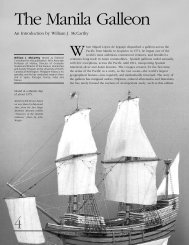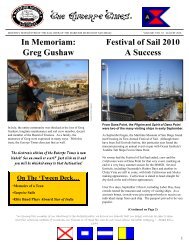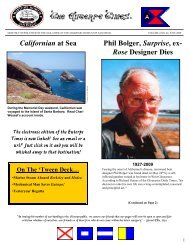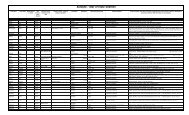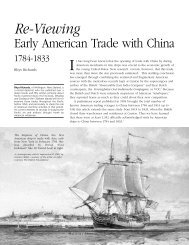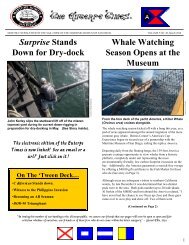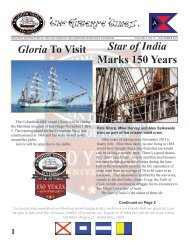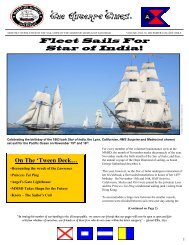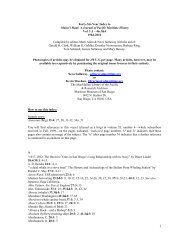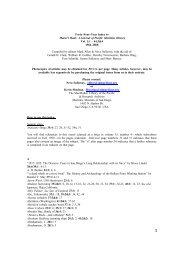Juan RodrÃguez Cabrillo And The Building Of The San Salvador
Juan RodrÃguez Cabrillo And The Building Of The San Salvador
Juan RodrÃguez Cabrillo And The Building Of The San Salvador
You also want an ePaper? Increase the reach of your titles
YUMPU automatically turns print PDFs into web optimized ePapers that Google loves.
of pearls. Pearls alone gave<br />
Cortés sufficient incentive<br />
to plan his own expedition.<br />
He was joined by a rush<br />
of volunteers who knew<br />
the captain’s reputation for<br />
finding wealth.<br />
Three vessels reached the<br />
Bay of La Paz on 3 May 1535.<br />
Cortés named the “island”<br />
<strong>San</strong>ta Cruz and founded its<br />
first settlement on the dry,<br />
rocky coast. Native hostility<br />
and a lack of food made<br />
it necessary for two ships<br />
to return to the mainland<br />
for supplies – one of these<br />
was wrecked in the Gulf of<br />
California – then called the<br />
“Red Sea of Cortés.” On a<br />
second attempt to obtain<br />
supplies, only the ship that<br />
Cortés himself commanded<br />
made it back across the<br />
treacherous, stormy waters to La Paz. In the meantime,<br />
twenty-three of his men died of starvation on Baja<br />
California’s inhospitable shore. Cortés took the one<br />
remaining vessel and returned to Mexico to get further<br />
relief. Finally, toward the end of 1536, prospects of<br />
success seemed so remote that Cortés sent ships to pick<br />
up the surviving colonists. Thus ended the first in a long<br />
succession of attempts to settle California. 9<br />
<strong>The</strong> Ulloa Expedition<br />
In 1539 Cortés issued instructions to the final<br />
expedition that, under his direction, would pierce the<br />
mysteries of the north. His plans to return to Spain<br />
to solidify his territorial claims, however, kept Cortés from<br />
accompanying the voyage. Three vessels commanded<br />
by Francisco de Ulloa sailed from the port of Acapulco in<br />
July of that year; one, the tiny <strong>San</strong>to Tomás was wrecked<br />
in the stormy waters of the Gulf of California before<br />
reaching La Paz. Ulloa’s fleet, reduced to the l20-ton<br />
<strong>San</strong>ta Agueda and its flagship, the Trinidad, a 35- to 40-<br />
ton vessel not more than forty feet in length, left La Paz<br />
and headed across the choppy Red Sea of Cortés to the<br />
Above: This distinctive map titled ‘T Gebiedt van Guadalajara Niew<br />
Mexico en Californie enz (ca 1656-1665), by French cartographer<br />
Nicolas <strong>San</strong>son, supported the myth that California was an<br />
island – a misconception which continued well into the 1700s.<br />
MMSD Maps and Charts Collections<br />
mainland shore. Ulloa cruised northward to the port of<br />
Guaymas, which he named Puerto de los Puertos (the<br />
Port of Ports), and further on expected to find a passage<br />
around the “island” of California. Instead, the ships<br />
encountered violent tides caused by the Colorado River<br />
descending into the sea at the head of the narrow Gulf.<br />
<strong>The</strong> bleak shoreline, a lonely desert broken by stark<br />
mountains, offered few prospects for golden cities, so<br />
Ulloa turned southward, the first Spaniard to know that<br />
Baja California was not an island.<br />
<strong>The</strong> two vessels rounded Cabo <strong>San</strong> Lucas by the end<br />
of January 1540, and then sailed up the western shore<br />
as far north as the Isla de Cedros (Island of Cedars) so<br />
named because . . . on the tops of the mountains<br />
therein, there grows a wood of these Cedars<br />
being very tall, as the nature of them is to be. 10<br />
S a n S a l v a d o r<br />
39



